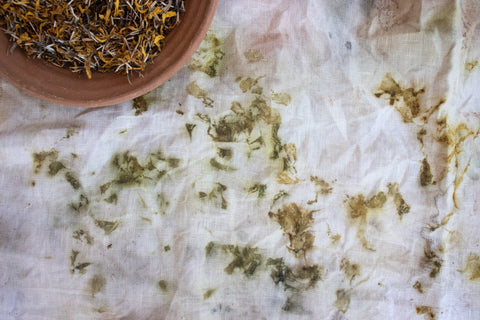
Eco-printing is the primary reason for our obsession with botanical prints! It first started with fun trials. I still remember, Iwould pick up random leaves and flowers, bundle them with fabrics and explode with excitement to unbundle the prints, only to realise that it’s not that simple. After years of experimenting with the process I winnowed down to the leaves and flowers that are both locally available and are commercially viable. That still doesn’t stop me from exploring. I keep trying to print with new leaves and flowers all the time. It’s an ever exciting process and there’s always more to learn!
Coming to what actually is eco-printing- it is a contemporary technique for printing with natural dyes. It is also commonlyreferred to as bundle dyeing. The process involves binding natural textiles or paper with plant materials that contain natural dyes, and steaming the bundles to extract prints onto the textile or paper.
At Unborn Studio, after steaming the bundles, we let them sit for about a week to let the dyes completely soak into the fibres to achieve rich hues. Unbundling is definitely the most exciting part of the process as we uncover the colours and unique impressions left behind by the leaves and dyes.
Like natural dyeing, eco-printing is a slow and labour-intensive process. Since natural dye molecules don’t readily adhere to natural fibres, the fabrics are first treated with a substance known as mordant. Mordants essentially prepare the fabrics for dyeing. Not all the mordants are safe to use as some of them contain heavy metal elements that could be harmful to the environment as well as humans. Due to this reason, we only use natural mordants like Alum, Myrobalan, Oak galls, and Soy milk.
Natural mordants




In most cases, plant materials used for printing are the fallen leaves and flowers which are collected from the local gardens in and around our dye studio. Since prints are created only at the contact of the leaf and fabric, the dye stuff required to print a fabric is significantly lesser compared to what is required for traditional natural dyeing technique. This in turn creates less waste and makes this process more efficient. Another reason why Eco-printing severs as a great alternative is that it uses minimum water as multiple fabric pieces are steamed together and the water used to steam is be reused to water our dye garden, making it a zero-water-waste dyeing process.
Marigold petals on linen

Eco-print patterns on the textiles are so graceful and elegant with a visually-soothing effect. The delicate patterns of the leaves and flowers almost make it seem like nature is frozen in time. The prints obtained are always quite phenomenal as each leaf or flower is unique and hence each dyed piece is truly one of its kind.

